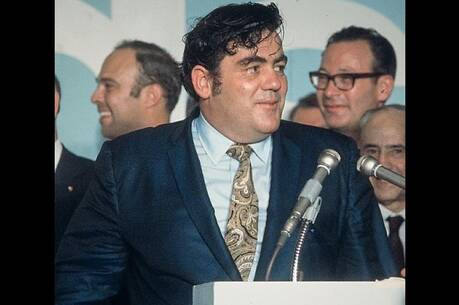Museum of the Mind
Incorporating the title of Wallace Stevens’s first collection of poetry (Harmonium, 1923), this is Paul Mariani’s sixth literary biography, preceded by his lives of Hopkins, Berryman, Lowell, Williams and Hart Crane. Mariani adds his seasoned wisdom and remarkable narrative skills in capturing a poet’s ethos to earlier and current Stevens biographies by Joan Richardson, Alison Johnson and Al Filreis.
Mariani’s impeccable research and perceptive readings of the Stevens canon make The Whole Harmonium essential reading on Stevens’s place in American and world poetry. According to Mariani, Stevens is “among the important poets of the twentieth and the still-young twenty-first century, sharing a place with...Rilke, Yeats and Neruda.” But The Whole Harmonium is more than a biography; it is a history of high modernism that Stevens helped to create, define and exemplify through his poetry, aesthetics and friendships with figures like Harriet Monroe (the founder of Poetry magazine), Marianne Moore, William Carlos Williams, Carl Van Vechten and James Latimer.
In fascinating detail gathered from a wealth of documents, including letters, speeches, journals, interviews, business reports, genealogies and photographs, Mariani reveals a Stevens who was as complex a human as he was a poet. He plumbs Stevens’s family background, personality and influences more insightfully than other biographers have done. Mariani claims there were two sides to Stevens: ”the unhappy Stevens,” who nonetheless devoted his life without cynicism to seeing things through the lens of the sublime, and the worldly connoisseur who “caught the gaiety, the parasols and chocolate, the complacencies of the peignoir, even the blaze of the tiger’s eye.”
A paradoxical, domestically troubled Stevens emerges. A large man (in a linebacker’s frame) with a tiny scrawl, intensely private, “abrupt” and “dismissive,” he was estranged from his own family, especially his father, who disapproved of his marriage. He was caught in a loveless marriage to the “steely cold” Elsie Kachel Moll, whom a niece described as a “’church mouse without a sense of humor” and who banished Stevens, suspecting him—without grounds—of adultery, first to the attic and then to his own bedroom, where his poetry, Mariani contends, served as an imaginative substitute for the woman he had lost. It was the Rev. Arthur Hanley, a Catholic chaplain, who administered the sacraments to Stevens (this poet who had once described himself as a “dried-up Presbyterian”) on his deathbed. And it was Hanley who learned firsthand that Stevens clearly “lived on a higher or different plane than she did.”
Educated as a lawyer, Stevens switched to the insurance business (a career more suited to his personality) and eventually became vice president for surety claims at the Hartford Accident and Indemnity Company, a position he held for the last 20 years of his life. For him, poetry was an “affair of holidays and weekends,” something he did walking to and from work.
Yet the writer inside the man was imbued with a different spirit. As Mariani put it, the “Stevens of Harmonium...[was] the mandarin poet, the Frenchified dandy, the lawyer-poet of inscrutable edifice” who searched for and celebrated the sublime through his poems. Imagination became the true reality for Stevens, the very oxygen he breathed. In an early chapter, “An Explosion in a Shingles Factory,” referring to The New York Times’s derogatory description of Duchamp’s “Nude Descending a Staircase,” Mariani takes us on a colorful tour of Stevens’s museum of the mind. Living life to the fullest, the younger Stevens entered the world of sultanas, tambourines and sapodillas, indulging himself in surf baths, “the sun and martinis,” exotic teas imported from Ceylon, Cuban cigars, the arts, gardening and long walks when “the green evenings were clear and warm.”
In the “paradisal green” of Key West, where Stevens went yearly for the winter vacations he combined with business trips, he enjoyed card games, fishing and drinking bouts, and once “broke his fist in two places” in a fight with Ernest Hemingway. Yet even in this Arcadia, he was concerned with the two major concepts that shaped his life and work—order and the sublime. “How does one stand/ to behold the sublime/ To confront the mocker/ The mickey mockers/ And plated pairs,” he asked in “The American Sublime.” Music in particular charmed him; it was something he always played at home and played with in his poetry as well. In one of his most famous poems in Harmonium,“Peter Quince at the Clavier,” he declared that “Music is feeling, then, and not sound.”
Mariani does an exemplary job of capturing this zestful Stevens through the publication of his Man With the Blue Guitar & Other Poems (1937). But no less compelling or sensitive is Mariani’s biography of the prodigious Stevens in his 50s and beyond, asserting that later in life Stevens the dandy “assumed the New England conscience of a Dickinson or Hawthorne.” Mariani is at pains to show how Stevens’s later works differed from those in Harmonium. Drawing upon a wellspring of correspondence, talks and journals, he provides studied analyses of Stevens as thinker and theorist, ever mindful of Stevens’s burgeoning reputation and legacy.
Poetry for Stevens was not personal, ideological or political (though he was horrified by wars and despised Fascism). Though Mariani scrupulously contextualizes people and events in Stevens’s life (e.g., cocktail events, parties, trips, literary tastes) that inspired or float through his works, he rightfully insists that it would be misleading to tag Stevens an autobiographical poet in the accepted sense, for, as Elizabeth Drew, a reviewer for The Atlantic Monthly, speaking for many readers, phrased it, Stevens intended poems to be “’beautifully phrased and condensed enigmas.’” Even Robert Frost quipped that Stevens’s poetry was too hard because “it made him think.” But as Mariani emphasizes, the poetry is autobiographical in the sense that it is “an activity of the mind equal to and even greater than philosophy.” If Stevens’s poetry was difficult, abstract and intensely intellectual, it was because, like Picasso and Braque, he kept trying to locate the real within “the inaccessibility of the abstract,” for what was “there in life except one’s ideas?”
Ever the metaphysician, Stevens placed inestimable value on how we see and perceive things; “13 Ways of Seeing a Blackbird,” “Yellow Afternoons” and “Women Looking at a View of Flower” are proof texts of his ontology. A poet steeped in philosophical axioms (“Let be be finale of seems” in “The Emperor of Ice-Cream”), he eschewed the crusty pathetic fallacies that encumbered generations of earlier poets. Though he spurned being labeled “a dated Romantic,” he formulated an Ars Poetica for his own brand of Romanticism, since “there was no going back, copying… Shelley or Wordsworth or Keats or Whitman.” In “Tea at the Palaz of Hoon,” he locates “the golden raiment” (the poet’s powers) inside the poet himself and not in nature: “Out of my mind the golden raiment rained,/ And my ears made the blowing hymns they heard./ I was myself the compass of the sea:/ I was the world in which I waked, and what I saw/ Or heard or felt came not but from myself/ And there I found myself more truly, more strange.” And yet, despite his heady abstractions, many of his poems are beautifully lyrical, filled with haunting scenes from nature.
Stevens, no lover of organized religion, was nonetheless drawn to the spiritual. He defended the idea of a merciful God and often visited churches, especially St. Patrick’s Cathedral in New York City for its peaceful sanctity. Heavily influenced by his Harvard philosophy professor, George Santayana, Stevens saw poetry itself as a religion. With almost vatic powers, the poet was “the maker of a thing yet to be made” (“Blue Guitar”). Poems express and are themselves “the essence of reality,” because “Poetry should be the subject of the poem.” Stevens prayed through his poems, the vehicles by which he sought the Supreme Fiction, the poetic equivalent of God and grace. “God is Good, It Is a Beautiful Night” from Transport to Summer (1947) reflects Stevens’s strong sense of the transcendent caught in listening to the “brown bird” whose “thin music” rises from the “stump/ Of summer.” Dying of stomach cancer and still believing that the imagination was the gateway to the Sublime, Stevens, Mariani argues, could be satisfied only by “coming into the fold” and joining the Catholic Church, receiving baptism and Communion at St. Francis Hospital in Hartford. Ironically, his last poem prophetically welcomes the Holy Spirit’s entrance into his life with the image of “fire fangled feathers dangling down.” Mariani’s magisterial biography is a tribute to one of America’s most profound poets.
This article also appeared in print, under the headline “Museum of the Mind,” in the June 20-27, 2016, issue.








